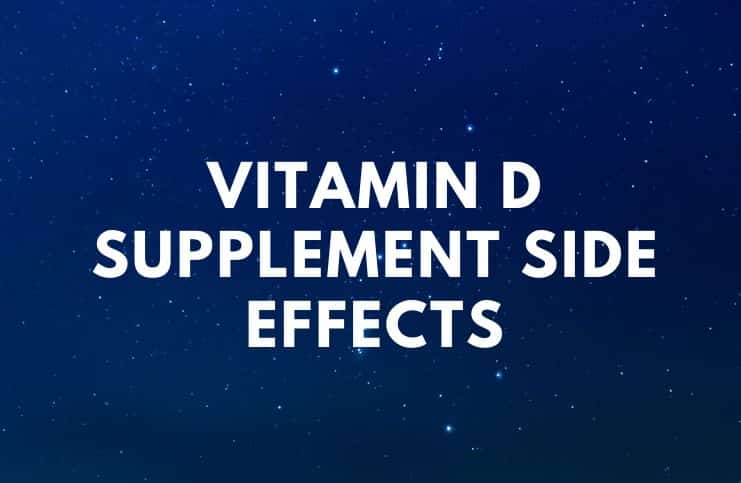Vitamin D Supplement Side Effects:
The body produces vitamin D when the skin is directly exposed to the sun. This is why it is often called the “sunshine” vitamin.
During exposure to sunlight, the ultraviolet B photons enter the skin and photolyze 7-dehydrocholesterol to pre-vitamin D3, which in turn is isomerized by the body’s temperature to vitamin D3.
We need this vitamin to help the body absorb phosphate and calcium from our diet. These minerals are important for teeth, healthy bones, and muscles.
According to a study, optimal levels of this vitamin can slash your risk of cancer by as much as 60%. Keeping your levels optimized can help prevent many types of cancer, including ovarian, pancreatic, lung, prostate, and skin cancers.
In spite of its name, it is considered a pro-hormone and not actually a vitamin. This is because the body is capable of producing its own vitamin D through the action of sunlight on the skin, while vitamins are nutrients that cannot be synthesized by the body and must be acquired through the diet.
The difference between D3 and D2
Vitamin D3, also known as cholecalciferol, is created when ultraviolet rays (UVB) react with 7-dehydrocholesterol.
This cholesterol molecule is naturally present in the skin of humans and animals, and in milk. According to the latest research, D3 is approximately 87% more potent in maintaining and raising vitamin D concentrations and produces greater storage of vitamin D than does D2.
Vitamin D2, also known as ergocalciferol, is derived from fungal and plant sources, such as mushrooms. Again, these plants contain a precursor molecule that converts to vitamin D2 when exposed to UVB rays.
Regardless of which form you use, your body must convert it into a more active form, and vitamin D3 is converted 500% faster than vitamin D2.
How much sunshine does it take to make enough Vitamin D?
10 to 20 minutes of sunshine three times a week is sufficient to produce the body’s requirement of vitamin D.
There are many factors that affect the skin’s capacity to produce vitamin D: time of day, season, body parts exposed, latitude and altitude, skin color, air pollution, the ozone layer, cloud cover, sunscreen, color, and age. A sunscreen with sun protection factor 30 can reduce the body’s capacity to synthesize the vitamin by 95 percent.
Constantly going outside for a few minutes around the middle of the day without sunscreen is suggested as best, and “the more skin that is exposed, the greater the chance of producing sufficient vitamin D before burning.”
Your physical body can only produce a limited amount of vitamin D every day. Caucasians and others with paler skin will hit an “equilibrium point” after about 20 minutes of exposure to UVB light, at which point vitamin D will no longer be produced.
Once it reaches its limit, you only cause damage by going beyond that amount. However, individuals with dark skin, such as those of African, African-Caribbean, or South Asian origin, will need to spend longer in the sun to produce the same amount of vitamin D as someone with lighter skin.
If you have darker skin, reaching this equilibrium point can take 2 to 10 times longer, depending on your pigmentation.
Health Benefits
Vitamin D deficiency has also been linked with an increased risk of cardiovascular disease, multiple sclerosis, hypertension, autism, rheumatoid arthritis, Alzheimer’s disease, asthma severity, and swine flu. However, more reliable studies are needed before these associations can be proven.
Moreover, research has shown that this vitamin might play an important role in regulating mood and warding off depression.
Hypervitaminosis D – side effects of Vitamin D supplement
It has been proven time and again that isolating nutrients in supplement form will not provide the same health benefits as consuming the nutrients from whole foods.
First concentrate on obtaining your daily vitamin D requirement from sunlight, then use supplements as a backup.
Vitamin D is a fat-soluble vitamin. Fat-soluble vitamins can build up in the body and are not as easily excreted as water-soluble vitamins.
Hence, Vitamin D overdose causes hypercalcemia, and the main symptoms are: nausea, anorexia, and vomiting, frequently followed by weakness, polyuria, polydipsia, insomnia, pruritus, nervousness, and, ultimately, renal failure. Proteinuria, azotemia, urinary casts, and metastatic calcification (particularly in the kidneys) may develop.
Additionally, too much vitamin D can make the intestines absorb too much calcium. This may cause high levels of calcium in the blood.
High blood calcium can lead to confusion and disorientation, calcium deposits in soft tissues such as the lungs and heart, damage to the kidneys, kidney stones, weakness, nausea, constipation, vomiting, poor appetite, and weight loss.
Note
Scientists state that levels of vitamin D in pregnant women may not affect the baby’s bone health – contrary to official advice.
They found no connection between a mother’s levels of vitamin D while carrying the child, and the latter’s bone health at the age of 10. Professor Debbie Lawlor, who led the ”Children of the 90s” study at Bristol University, said – ”There was no strong evidence that pregnant women should be taking vitamin D supplements.”
A 2014 analysis of the studies by the Department of Medicine, University of Auckland, Auckland established that – ”Our findings suggest that vitamin D supplementation with or without calcium does not reduce non-skeletal or skeletal outcomes in unselected community-dwelling individuals by more than 15 percent.
Future trials with similar designs are unlikely to alter these conclusions.”
Even though there is an association between lower vitamin D status and type-2 diabetes, heart disease, strokes, common cancers (prostate, breast, and colon), and multiple sclerosis, treatments with vitamin D supplements have not been shown to be effective for these conditions.
READ THIS NEXT:
Foods to Avoid on a Tyramine Restricted Diet
References http://onlinelibrary.wiley.com/doi/10.1111/j.1365-2796.2008.02008.x/abstract http://www.nhs.uk/news/2010/12December/Pages/sunlight-exposure-and http://www.dailymail.co.uk/health/article-2295550/Taking-Vitamin-D http://www.ncbi.nlm.nih.gov/pubmed/24703049

